A complete codebook of Napoleon
( )
(
)
( )
)
Presentation of the code F18
The code titled "F 18" was used by the Emperor's troops during the Hundred days to communicate with the commanders of the strongholds.
It is made up of 1,200 groups. This is the common size of a great cipher of the time. Codes used by the Emperor himself could reach 3000 groups. In the archives I found the two tables (which is rare): to encrypt (C), and to decrypt (D) but also (which is exceptional) the user manual.
It is a disarranged code (two parts code). Each group means:
- A letter: ABC ... Z, the letters I and U are absent and are replaced by J and V.
- One syllable: ba, be, bi, bo, bu, …
- A polygram : ition, ...
- A word :
- A common name: fight, dispatch, always, ...
- A proper name: a continent (America, Europe), a sea (Baltic, Mediterranean), a Country (France, Spain, Holland,…), a City (Naples, Copenhagen, Hamburg, London,…).
Notes:
A group often representing several variations of the same word: the word in the singular, the plural, the masculine, the feminine, the feminine plural as well as other words having the same root.
880 = co, lonie, ale, s. It allows to code: co, colonie, coloniale, coloniales
250 = peu, x, t. It allows to code: peu, peux, peut
353 = tout, e, es. It allows to code: tout, toute, toutes
1083 = fort, e, ce, s.It allows to code: : fort, forte, force, forts, forces
835 = an, née, s. It allows to code: : an, année, années, année, ans
546 = conclu, re, sion, s.It allows to code: : conclu, conclus, conclure, conclusion, conclusions
709 = manifeste, r, mt. It allows to code: : manifeste, manifester, manifestement
The widely used letters, syllables or words were coded by several groups:
du = 1150, 407, 960, 241 well, s = 1170, 218 this, te = 247, 968, 1175 war, s = 662, 104 & = 460, 1124, 62, 965, 807
Special groups:
- A group allows you to cancel the code that precedes it. This type of group already existed in royal times. But in the F18 code, there is also a group to cancel the current line.
- In the codes of the royal era, there were groups that had no meaning to deceive the enemy. These groups were designated with the name "null". This type of group is absent from the F18 code. On the other hand, there are two groups which cancel the meanings of the groups which are between them (cf. the manual). Another group cancels the rest of the line and the rest of the page.
- Many groups are used to signify the end of the mail.
The text (verbatim) of the manual
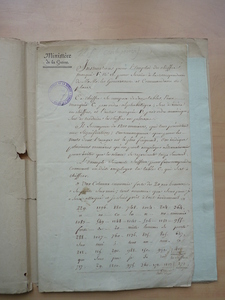
|
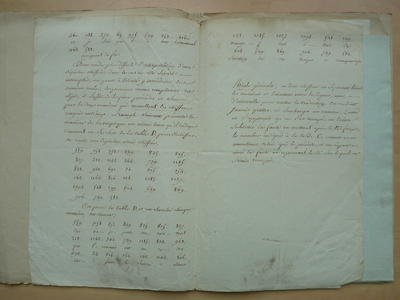
|
Instructions for using the codebook marked F. N ° 18. to serve for the correspondence of Gouvernors and Commanders of strongholds.
This codebook consists of two tables, one marked C, in alphabetical order; Used to encode, and the other marked D, in numerical order, Used to translate codegroups into sentences.
It consists of 1200 codegroups, all of which have meaning; we notice that for words whose use is the most frequent, we indicate several codegourps that can be used alternately to avoid that the same ones are represented too often.
The following example will suffice to explain how we must use the table C, which is used to encode.
" Une Colonne ennemie forte de 20,000 hommes,
" Se porte sur moi; tout annonce que sous peu je
" serais attaqué et je suis pret à tout évènement. "
Translation : "An enemy Column 20,000 strong,
"Wears on me; everything announces that shortly I
"would be attacked and I am ready for anything."
229. 1196. 880. 748. 1014. 204. 364. u --- ne --- Co --- lo --- n --- ne - ennemie 1083 -- 549 -- 1148 - 1041 -- 536 -- 1181 - 955 - forte - de --- 20 -- mille hommes se porte 288 - 1027 - 760 - 1136. 835. 805. 647. Sur - moi ; tout an - non - ce 212. 115. 290. 988. 150. 958. 410 que Sous peu je se rai annulent les chiffres 717. 29. 1200. 975. 360. 171. 1103 273 ---------------------------- Compris entre eux - attaqué 460. 988. 270. 65. 975. 539. 353. 416. et je suis pre t à tout événement 1164. 583. . marquant la fin.To make the interpretation of an encrypted dispatch more difficult, in the event that it is intercepted, one can enter null codegroups at will; the first comers fill this object, it suffices to precede and follow them by the two numbers which cancel out the codegroups included between them. The following example shows how to use them, at the same time as it shows how to use table D, to decipher.
We receive a dispatch thus encrypted.
559. 958. 352. 849. 835. 805. 827. 212. 1142. 364. 739. 1185. 833. 963. 692. 24. 615. 154. 162. 1164. 806. 128. 1085. 1027. 1094. 548. 199. 604. 549. 869. 906. 749. 583.We take table D, and we look for each codegroup, we find;
559. 958. 352. 849. 835. 805. 827. des ra - p - ports an - non cent 212. 1142. 364. 739. 1185. 833. 963. que l - ennemi est en re - tra 692. 24. 615. 154. 162. 1164. 806. - ites- ; faites le suivre . alinéa 128. 1085. 1027. 1094. 548. 199. envoye - z moi L' état de 604. 549. 869. 906. 749. 583. situation de vos toupes . marquant la finGeneral rule; we must encrypt by separating the codegroups well and leaving enough space between the lines to put the translation. You should never scratch or overload a codegroup. When we realize that we have made a mistake, we allow the fault to remain by putting after the wrong codegroup, the codgroup indicated in table C, as canceling the one that precedes it, and we will thus repair the fault by resuming the codegroup on which we had made a mistake.
Comments about the Manual
In both cipher texts, there are some mistakes:- Codegroup 1041 was not found in either of the two tables. It is translated by "Mille" (thousand).
- In the second text, in the first line, the codegroup 849 is wrong. We should have had codegroup 847.
- 1164, 749 = dot (".")
- 760 = semicolon (";")
- 806 = new paragraph
- 880 = co, lonie, ale, s. In the text this group is used to translate the syllable "co".
- 748 = lo, i, r, st, t. In the text this group is used to translate the syllable "lo".
- 250 = peu, x, t.
- 353 = tout, e, es
- 1083 = fort, e, ce, s. In the text this group is used to translate the word "forte".
- 835 = an, née, s. In the text this group is used to translate the polygram "an".
Encryption and decryption tables
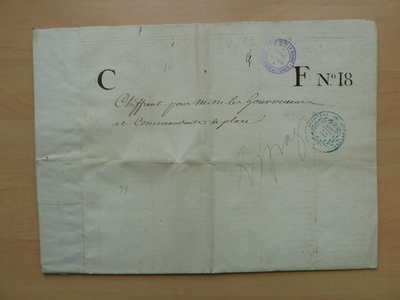
|
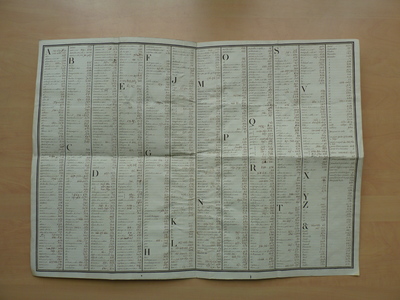
|
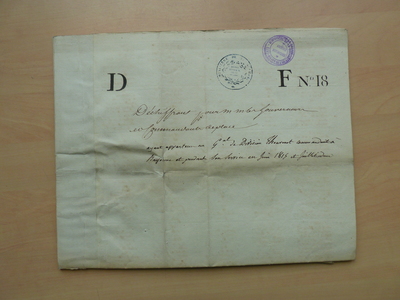
|
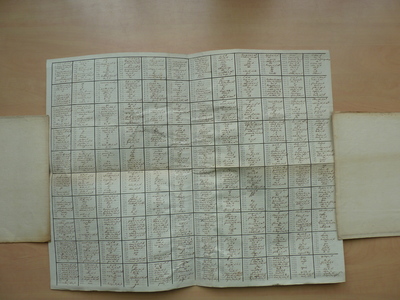
|
- C F N°18
- D F N°18
It is indicated that the copies belonged to Major General Thouvenot commander in Bayonne and during his service in June and July 1815.
The Major General Pierre Thouvenot
He was elevated to the rank of major general on November 25, 1813. From mid-February on May 5, 1814, he was governor of Bayonne, commander-in-chief of the troops who keep under the city walls thirty nine thousand soldiers of the army of Wellington who will never succeed in bending the French defense.Superior commander of Rochefort during the Hundred Days, he found his command in Bayonne on Napoleon's return. After Waterloo and the restoration of the Monarchy, which has always shown unwavering loyalty to the Emperor, was placed inactive on August 10, 1815, then retired on September 9 following.
References
- SHD – 1M 2352 – MEMOIRE DE CORRESPONDANCE REPUBLIQUE ET EMPIRE DOCUMENT GENERAUX CHIFFRES DE CORRESPONDANCE.
- Wikipedia - Pierre Thouvenot